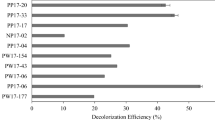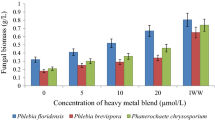Abstract
Background, aim and scope
Pulp and paper mills generate a plethora of pollutants depending upon the type of pulping process. Efforts to mitigate the environmental impact of such effluents have been made by developing more effective biological treatment systems in terms of biochemical oxygen demand, chemical oxygen demand, colour and lignin content. This study is the first that reports an evaluation of the effects of a tertiary treatment by fungi (Pleurotus sajor caju, Trametes versicolor and Phanerochaete chrysosporium and Rhizopus oryzae) on individual organic compounds of a Eucalyptus globulus bleached kraft pulp and paper mill final effluent after secondary treatment (final effluent).
Material and methods
The tertiary treatment with P. sajor caju, T. versicolor and P. chrysosporium and R. oryzae was performed in batch reactors, which were inoculated with separate fungi species and monitored throughout the incubation period. Samples from effluent after secondary and after tertiary treatment with fungi were analysed for both absorbance and organic compounds. The samples were extracted for organic compounds using solid-phase extraction (SPE) and analysed by gas chromatography–mass spectrometry (GC/MS). The efficiencies of the SPE procedure was evaluated by recovery tests.
Results
A total of 38 compounds (carboxylic acids, fatty alcohols, phenolic compounds and sterols) were identified and quantified in the E. globulus bleached kraft pulp mill final effluent after secondary treatment. Recoveries from the extraction procedure were between 98.2% and 99.9%. The four fungi species showed an adequate capacity to remove organic compounds and colour. Tertiary treatment with R. oryzae was able to remove 99% of organic compounds and to reduce absorbance on 47% (270 nm) and 74% (465 nm). P. sajor caju, T. versicolor and P. chrysosporium were able to remove 97%, 92% and 99% of organic compounds, respectively, and reduce 18% (270 nm) to 77% (465 nm), 39% (270 nm) to 58% (465 nm) and 31% (270 nm) to 10% (465 nm) of absorbance, respectively.
Discussion
The wide variety of organic compounds found in the final effluent must be due to the degradation of E. globulus wood in pulp and paper mill. The concentrations of organic compounds in the final effluent of E. globulus bleached kraft pulp mill were in residual levels maybe due to the secondary treatment. The recovery tests showed the effectiveness of the extraction procedure, and no losses of analyte were suspected in the analytical determinations. Lignin derivatives such as vanilic acid, syringic acid, guaiacol, syringol and phloroglucinol were totally removed by R. oryzae, but the 47% absorbance reduction obtained at 270 nm suggests that these species were not able to complete degradation of lignin macromolecular compounds.
Conclusions
The organic compounds (carboxylic acids, fatty alcohols, phenolic compounds and sterols) were removed more efficiently by tertiary treatment with R. oryzae or P. chrysosporium, followed by P. sajor caju and T. versicolor. Regarding the removal of both colour and organic compounds, the tertiary treatment with R. oryzae was the most efficient.
Recommendations and perspectives
In order to reduce the deleterious impacts of paper mill effluents, efforts have been made to develop more effective advanced tertiary treatments. This study may serve as a basis of characterisation, in terms of organic compounds of E. globulus bleached kraft pulp mill final effluent after secondary treatment and as an effort to understand the effects of tertiary treatments with fungi on low concentrations of organic compounds from biological secondary treatment.


Similar content being viewed by others
References
Ali M, Sreekrishnan TR (2001) Aquatic toxicity from pulp and paper mill effluents: a review. Adv Environ Res 5:175–196
Chandra R, Raj A, Purohit HJ, Kapley A (2007) Characterisation and optimisation of three potential aerobic bacterial strains for kraft lignin degradation from pulp. Chemosphere 67:839–846
Charlestra L, Courtemanch DL, Amirbahman A, Patterson H (2008) Semipermeable membrane device (SPMD) for monitoring PCDD and PCDF levels from a paper mill effluent in the Androscoggin River, Maine, USA. Chemosphere 72:1171–1180
Choudhury S, Sahoo N, Manthan M, Rohela RS (1998) Fungal treatment of pulp and paper mill effluents for pollution control. J Ind Pollut Control 14(1):1–13
Cui J, Chisti Y (2003) Polysaccharopeptides of Coriolus versicolor: physiological activity, uses and production. Biotechnol Adv 21:109–122
Cullen D, Kersten PJ (2004) Enzymology and molecular biology of lignin degradation. In: Bramble R, Marzulf GA (eds) The Micota III, biochemistry and molecular biology, 2nd edn. Springer, Heidelberg
Dignac M-F, Ginestet P, Rybacki D, Bruchet A, Urbain V, Scribe P (2000) Fate of wastewater organic pollution during activated sludge treatment: nature of residual organic matter. Wat Res 34:4185–4194
Duran N, Esposito E, Innicentini-Mei LH, Canhos PV (1994) A new alternative process for kraft E1 effluent treatment. Biodegradation 5:13–19
USEPA (2007) EPA method 3535A: solid-phase extraction (SPE), SW-846. USEPA, Washington, DC
Freitas AC, Ferreira F, Costa AM, Pereira R, Antunes SC, Gonçalves F, Rocha-Santos TAP, Diniz MS, Castro L, Peres I, Duarte AC (2009) Biological treatment of the effluent from a bleached kraft pulp mill using basidiomycete and zygomycete fungi. Sci Total Environ 407:3282–3289
Gokcay FC, Dilek FB (1994) Treatment of effluents from hemp-based pulp and paper industry (2) biological treatability of pulping effluents. Water Sci Technol 29(9):165–168
Hatfield R, Fukushima RS (2005) Can lignin be accurately measured? Crop Sci 45:832–839
Kim SW, Hwang HJ, Park JP, Cho YJ, Song CH, Yun JW (2002) Mycelia growth and exobiopolymer production by submerged culture of various edible mushrooms under different media. Lett Appl Microbiol 34:56–61
Meriläinen P, Lahdelma I, Oikari L, Hyötyläinen T, Oikari A (2006) Dissolution of resin acids, retene and wood sterols from contaminated lake sediments. Chemosphere 65:840–846
Miller JN, Miller JC (2005) Statistics and chemometrics for analytical chemistry. Prentice Hall, New York
Muñoz I, Rieradevall J, Torrades F, Peral J, Domènech X (2006) Environmental assessment of different advanced oxidation processes applied to a bleaching Kraft mill effluent. Chemosphere 62:9–16
Nagarathnamma R, Bajpai P (1999) Decolourization and detoxification of extraction-stage effluent from chlorine bleaching of kraft pulp by Rhizopus oryzae. Appl Environ Microbiol 65:1078–1082
NCASI (National Council of the Paper Industry for Air and Stream Improvement) (1971) Tech Bull No. 253. NCASI, New York
Nimelã K (1989) The formation of hydroxy monocarboxylic acids and dicarboxylic acids by alkaline thermochemical degradation of cellulose. J Chem Technol Biotechnol 48:17–28
NIST (1999a) Mass Spectral Library 27. Wiley, Hoboken
NIST (1999b) Mass Spectral Library 147. Wiley, Hoboken
NIST (1999c) Mass Spectral Library 229. Wiley, Hoboken
Pokhrel DT, Viraraghavan (2004) Treatment of pulp and paper mill wastewater—a review. Sci Total Environ 333:37–58
Prasad GK, Gupta RK (1997) Decolourization of pulp and paper mill effluent by two White-rot fungi. Indian J Environ Health 39(2):89–96
Ragunathan R, Swaminathan K (2004) Biological treatment of a pulp and paper industry effluent by Pleurotus spp. World J Microbiol Biotechnol 20:389–393
Rio JC, Gutiérrez A, González-Vila FJ, Martín F, Romero J (1998) Characterization of organic deposits produced in the kraft pulping of Eucalyptus globulus wood. J Chromatogr A 823:457–465
Sakurai A, Yamomoto T, Makabe A, Kinoshita S, Sakakibara M (2001) Removal of lignin in a liquid system by an isolated fungus. J Chem Technol Biotechnol 77:9–14
Saxena N, Gupta RK (1998) Decolourization and delignification of pulp and paper mill effluent by white rot fungi. Indian J Exp Biol 36:1049–1051
Thompson G, Swain J, Kay M, Forster CF (2001) The treatment of pulp and paper mill effluent: a review. Bioresour Technol 77:275–286
Valls C, Roncero MB (2009) Using both xylanase and laccase enzymes for pulp bleaching. Bioresour Technol 100:2032–2039
Witayakran S, Ragauskas AJ (2009) Modification of high-lignin softwood Kraft pulp with laccase and amino acids. Enz Microbiol Technol 44:176–181
Wingate KG, Stuthridge T, Mansfield SD (2005) Colour remediation of pulp mill effluent using purified fungal cellobiose dehydrogenase: reaction optimisation and mechanism of degradation. Biotechnol Bioeng 90:95–106
Acknowledgement
This work has been developed under the scope of the FCT (Portugal) funded research project, POCT/CTA/45030/2002: ‘Decolourisation of effluents from pulp and paper mills: removal of organic compounds and toxicity (DECORTOX)’.
Author information
Authors and Affiliations
Corresponding author
Additional information
Responsible editor: Thomas Braunbeck
Rights and permissions
About this article
Cite this article
Rocha-Santos, T., Ferreira, F., Silva, L. et al. Effects of tertiary treatment by fungi on organic compounds in a kraft pulp mill effluent. Environ Sci Pollut Res 17, 866–874 (2010). https://doi.org/10.1007/s11356-009-0288-0
Received:
Accepted:
Published:
Issue Date:
DOI: https://doi.org/10.1007/s11356-009-0288-0




